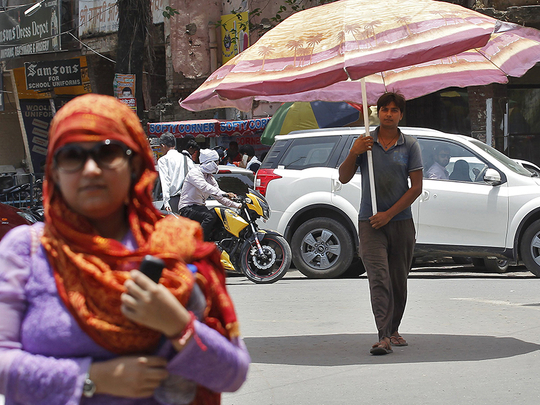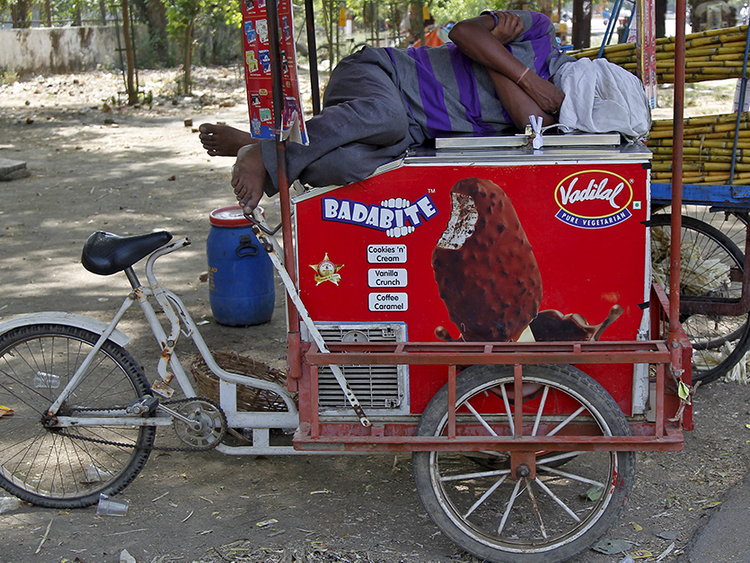
Hyderabad: Dizzying temperatures caused water shortages in thousands of Indian villages and killed hundreds more people over the past day, driving the death toll from the heatwave to at least 1,826, officials said Friday.
Meteorological officials called the heatwave “severe” and warned that it would continue for at least two more days across a huge swathe of the South Asian country, from Tamil Nadu in the south to the Himalayan foothill state of Himachal Pradesh.
Most of those killed by heat-related conditions including dehydration and heat stroke have been in the southern states of Andhra Pradesh and Telangana, where 100 people died just on Thursday as temperatures hovered about 43 degrees Celsius.
Thousands of water tankers were delivering supplies to more than 4,000 villages and hamlets facing acute water shortages in the central state of Maharashtra, state officials told the Press Trust of India news agency.
People across India were plunging into rivers, staying in the shade and drinking lots of water to try to beat the heat. Scorched crops and dying wildlife were reported, with some animals succumbing to thirst.
Many farmers and construction workers struggling with poverty were still working outdoors despite the risks. They along with the impoverished elderly were among the most vulnerable.
Cooling monsoon rains were expected next week in the south before gradually advancing north.
However, forecasting service AccuWeather warned of prolonged drought conditions, with the monsoon likely to be disrupted by a more active typhoon season over the Pacific.
“While there will be some rainfall on the region, the pattern could evolve into significant drought and negatively impact agriculture from Central India to much of Pakistan,” senior meteorologist Jason Nicholls at AccuWeather said in a statement. Experts say the official figures likely understate the true impact because heatstroke disproportionately affects the poor and homeless, who are less likely to die in hospitals.
Most of the confirmed deaths are in the southern states of Telangana and Andhra Pradesh, where doctors described hospitals overflowing with victims of severe heatstroke.
P Tulsi Rani, special commissioner for disaster management in the state, said the high number of deaths was down to record high temperatures over a longer period that usual.
“So many people died this year because the heatwave is continuing for a longer period than it normally does, and also record temperatures have been recorded in a number of places,” he said.
“It [the heatwave] has been continuing for a longer period, for about seven to eight days now, whereas usually it only lasts for a few days.”
Authorities in Telangana said they were running a television campaign to teach people how to stay cool and recognise the symptoms of heat stroke, which can be fatal if left untreated.
Streets of the state capital Hyderabad were deserted during the hottest period of the day, with many shops and businesses shut.
“All month I’ve basically stayed inside the house,” said 28-year-old Tejaswini Madhabhushi, who works at a policy institute in the city.
“The biggest problem is the power cuts. If they cut power in the afternoon then it gets unbearably hot, and we also run into a water shortage since the overhead tanks can’t be refilled.”
Syed Samad, who owns a business renting out air conditioning units, said trade was brisk.
“All our units have been leased out throughout April and May, which has never happened before,” he said.
Authorities in Delhi, where top temperatures have hit 45 degrees Celsius, ordered hospitals to treat heat stroke victims as emergency cases.
“The main thing is prevention in this situation, to ensure that preventive measures are being taken,” said Charan Singh, additional director of public health in the state government.
The surge in demand for electricity from air conditioners led to power cuts in parts of Delhi, exacerbating the misery for residents of the capital.
Unconfirmed reports said two people had died in Delhi, where tens of thousands sleep on the streets with little protection from the heat.
Authorities in eastern Orissa state said they had 12 confirmed deaths from heatstroke and were investigating the cause of another 80.
India declares a heatwave when the maximum temperatures hit 45 degrees Celsius, or five degrees higher than the average for the area in previous years.
The monsoon is forecast to hit the southern state of Kerala on May 30 before sweeping across the country, but it will be weeks before the cooling rains reach India’s arid plains.













